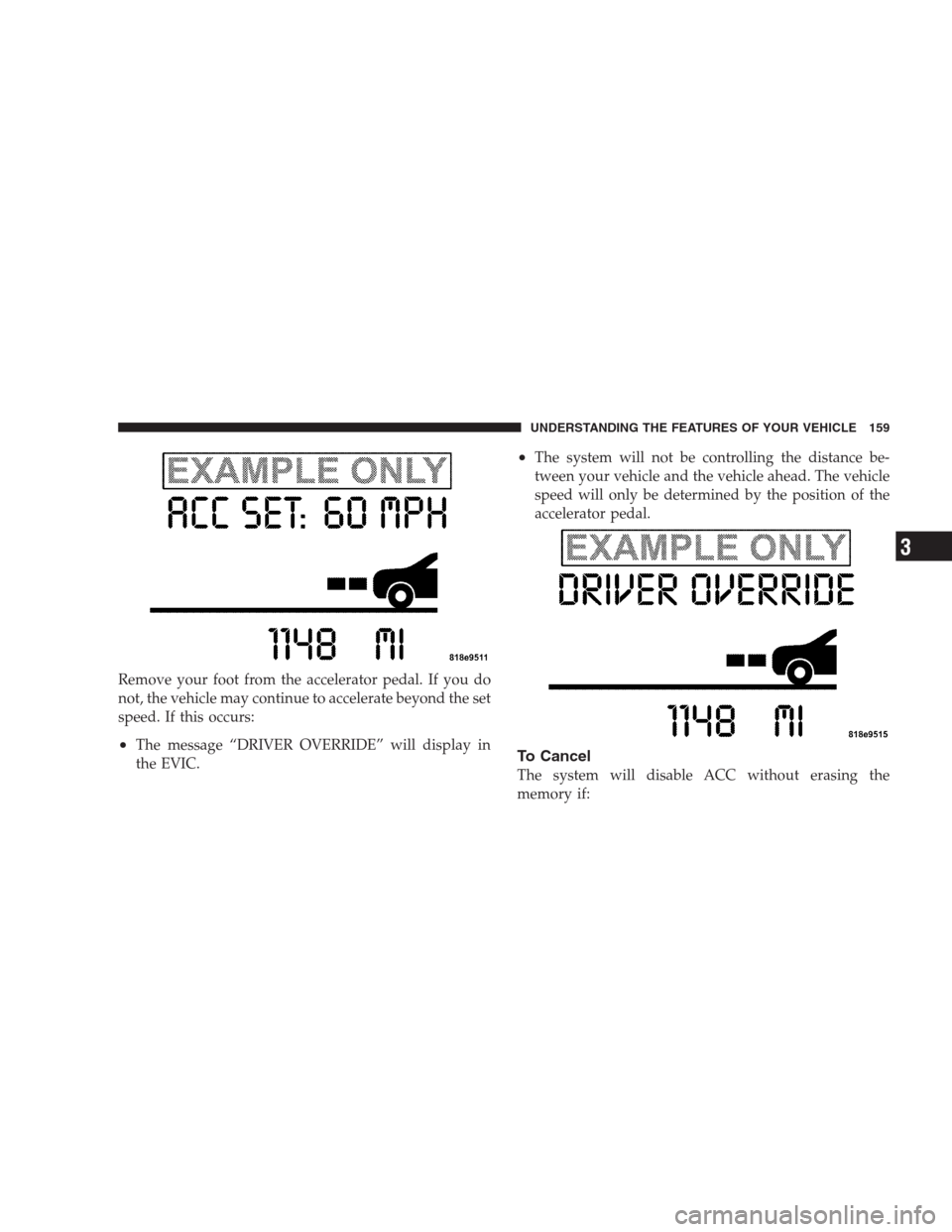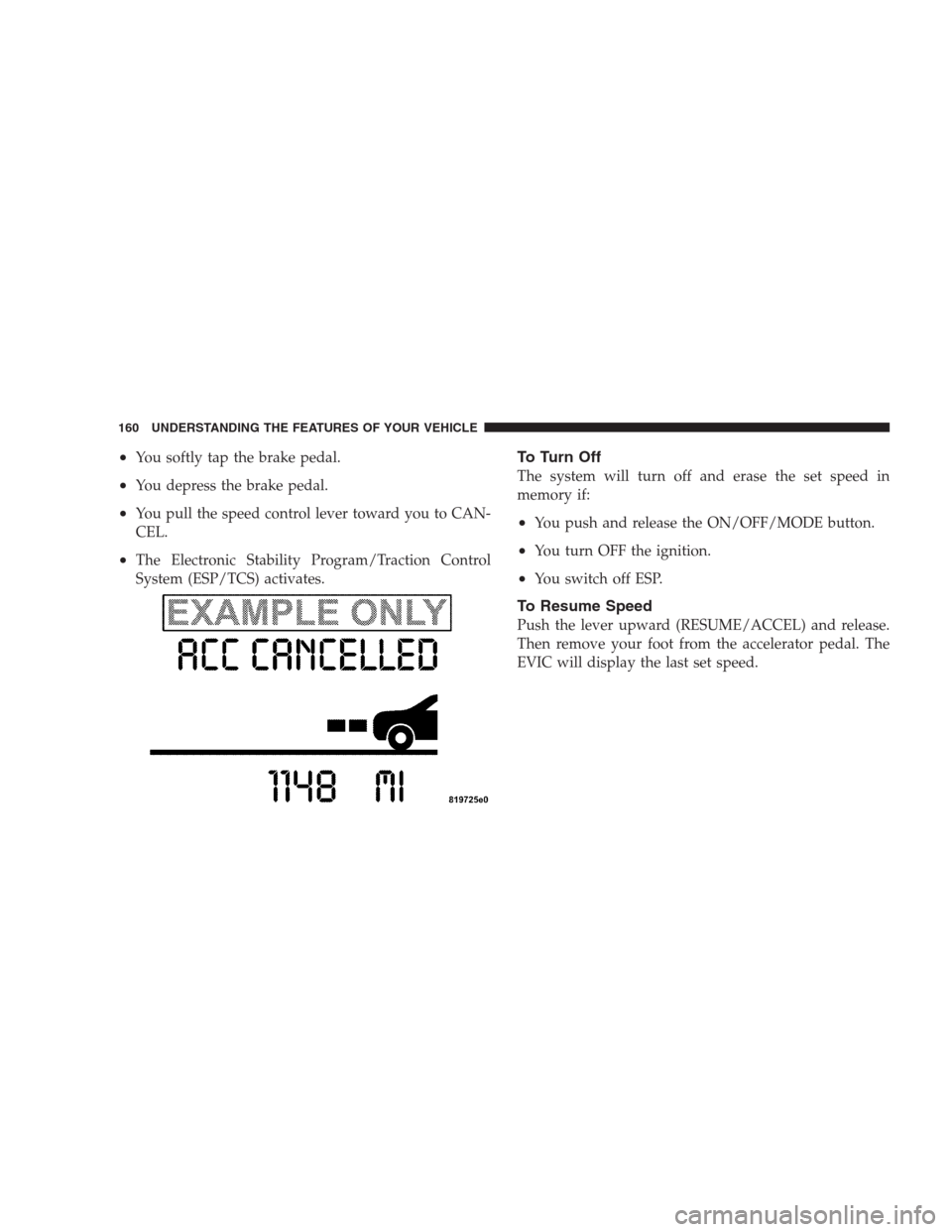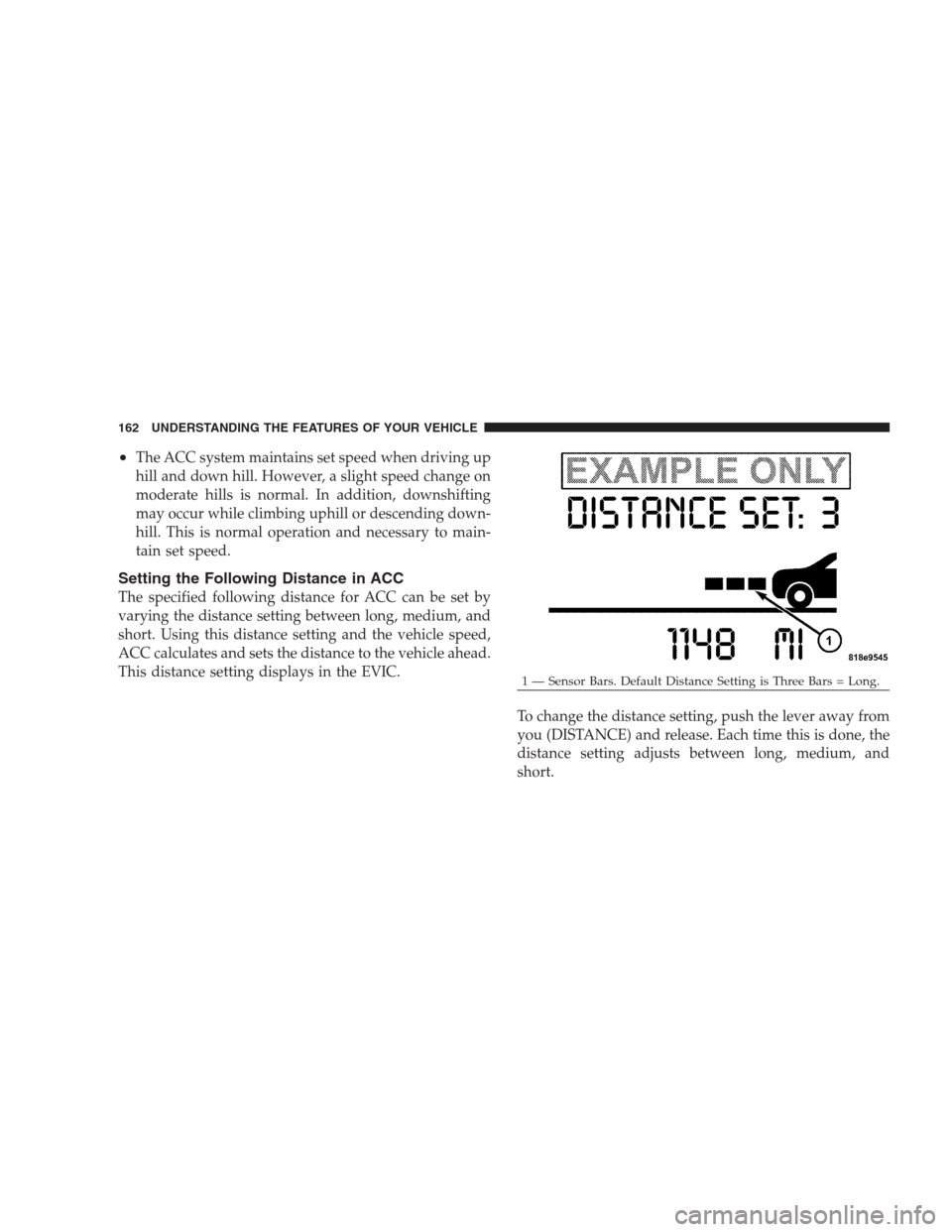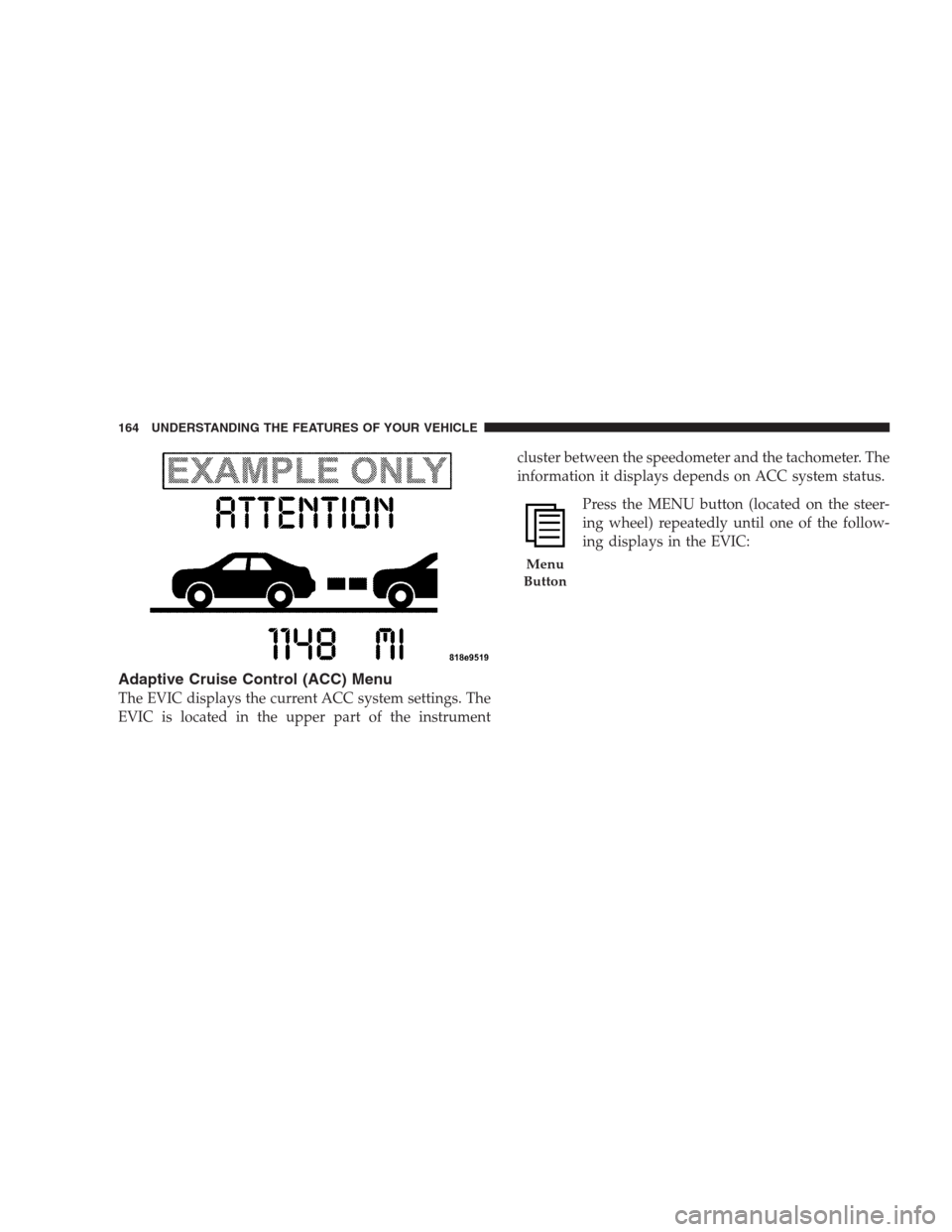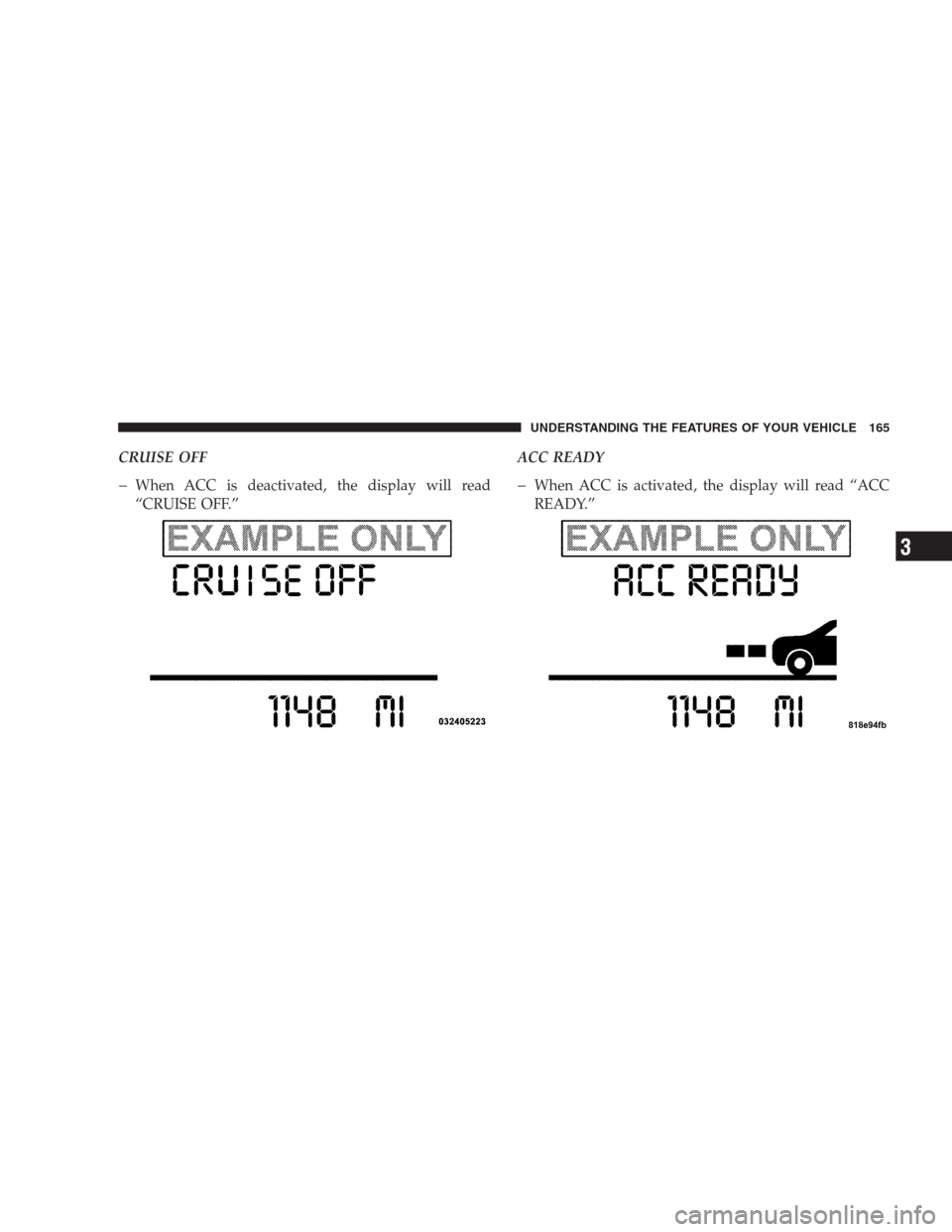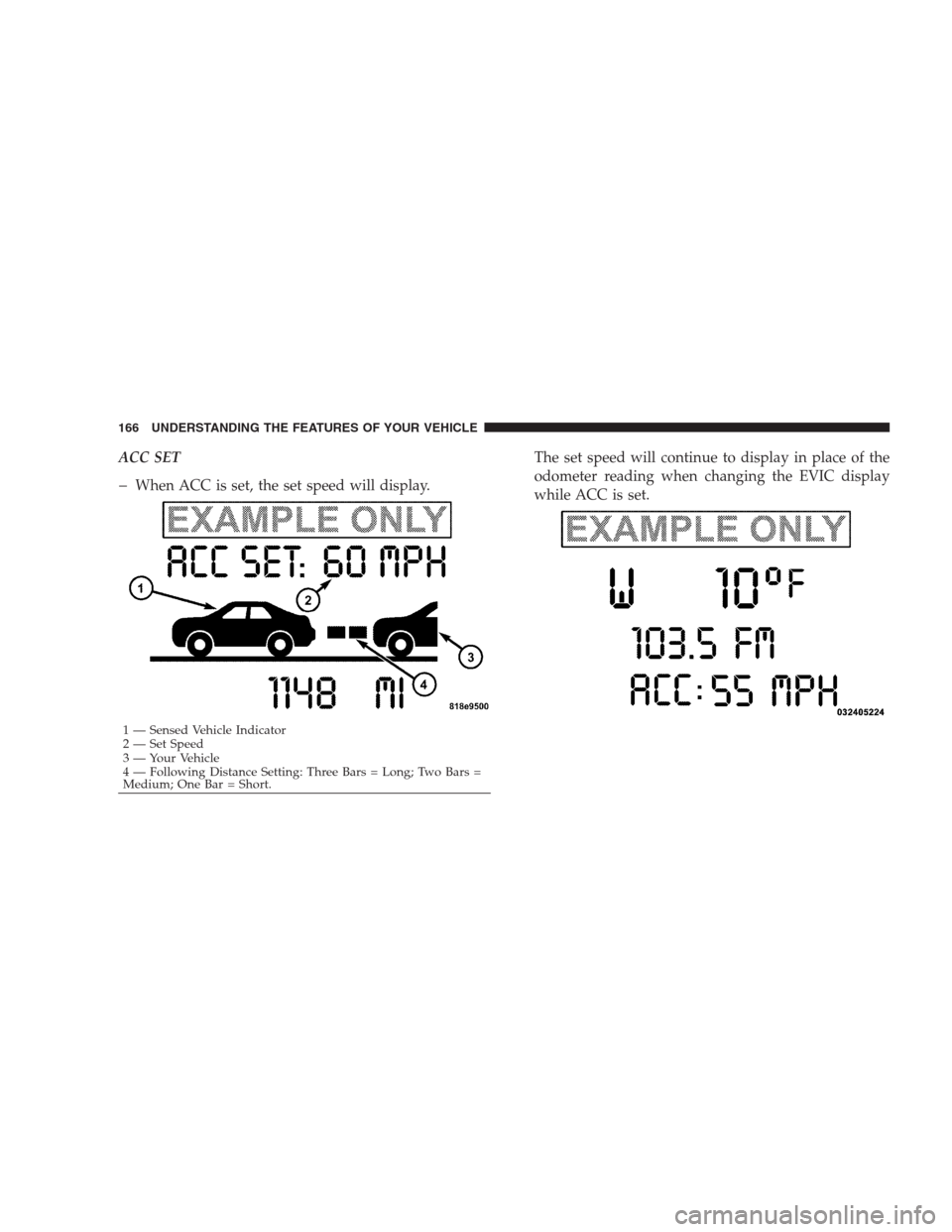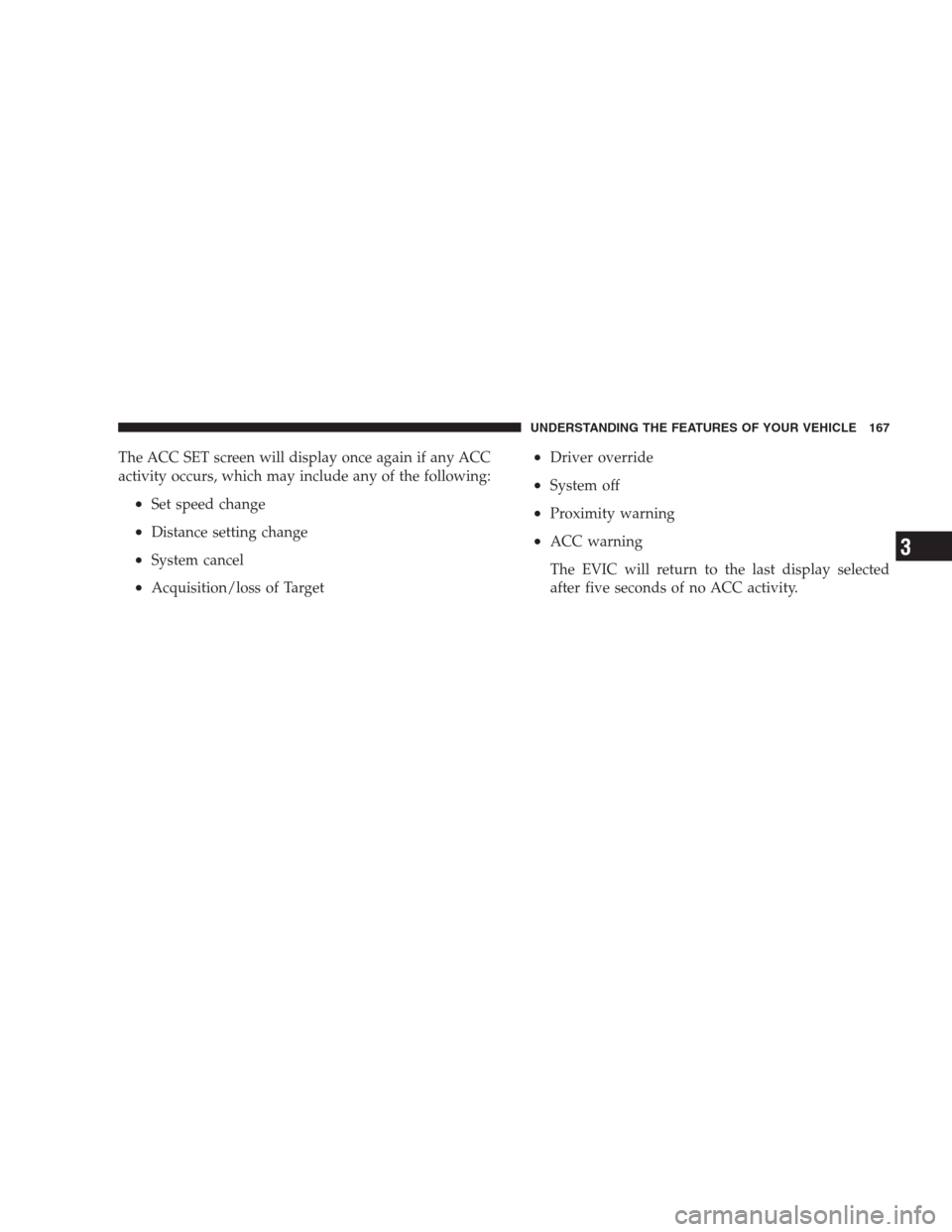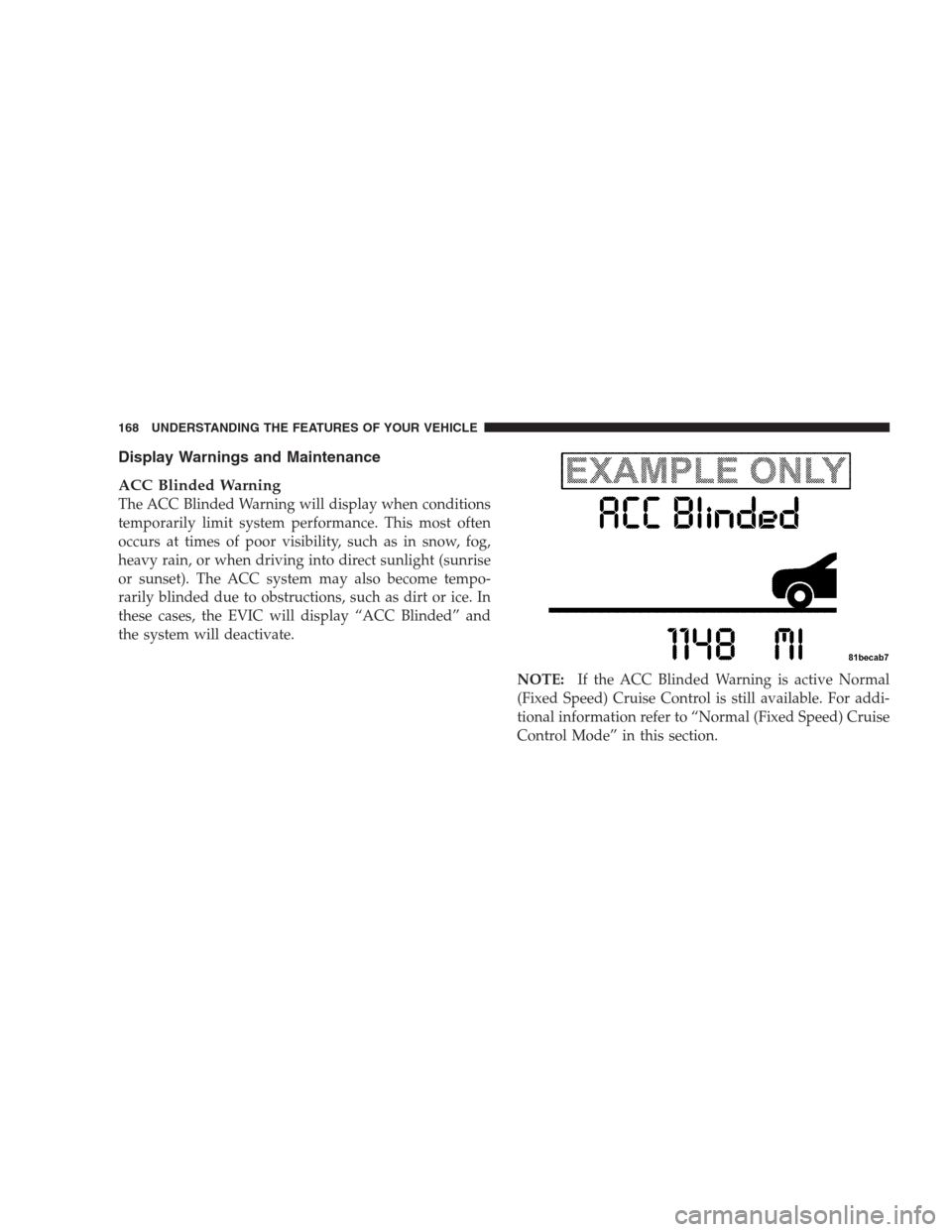CHRYSLER 300 2009 1.G Owners Manual
300 2009 1.G
CHRYSLER
CHRYSLER
https://www.carmanualsonline.info/img/25/8416/w960_8416-0.png
CHRYSLER 300 2009 1.G Owners Manual
Trending: seat memory, trip computer, rear entertainment, tire type, AUX, wipers, coolant
Page 161 of 526
Remove your foot from the accelerator pedal. If you do
not, the vehicle may continue to accelerate beyond the set
speed. If this occurs:
•The message “DRIVER OVERRIDE” will display in
the EVIC.
•The system will not be controlling the distance be-
tween your vehicle and the vehicle ahead. The vehicle
speed will only be determined by the position of the
accelerator pedal.
To Cancel
The system will disable ACC without erasing the
memory if:
UNDERSTANDING THE FEATURES OF YOUR VEHICLE 159
3
Page 162 of 526
•You softly tap the brake pedal.
•You depress the brake pedal.
•You pull the speed control lever toward you to CAN-
CEL.
•The Electronic Stability Program/Traction Control
System (ESP/TCS) activates.
To Turn Off
The system will turn off and erase the set speed in
memory if:
•You push and release the ON/OFF/MODE button.
•You turn OFF the ignition.
•You switch off ESP.
To Resume Speed
Push the lever upward (RESUME/ACCEL) and release.
Then remove your foot from the accelerator pedal. The
EVIC will display the last set speed.
160 UNDERSTANDING THE FEATURES OF YOUR VEHICLE
Page 163 of 526
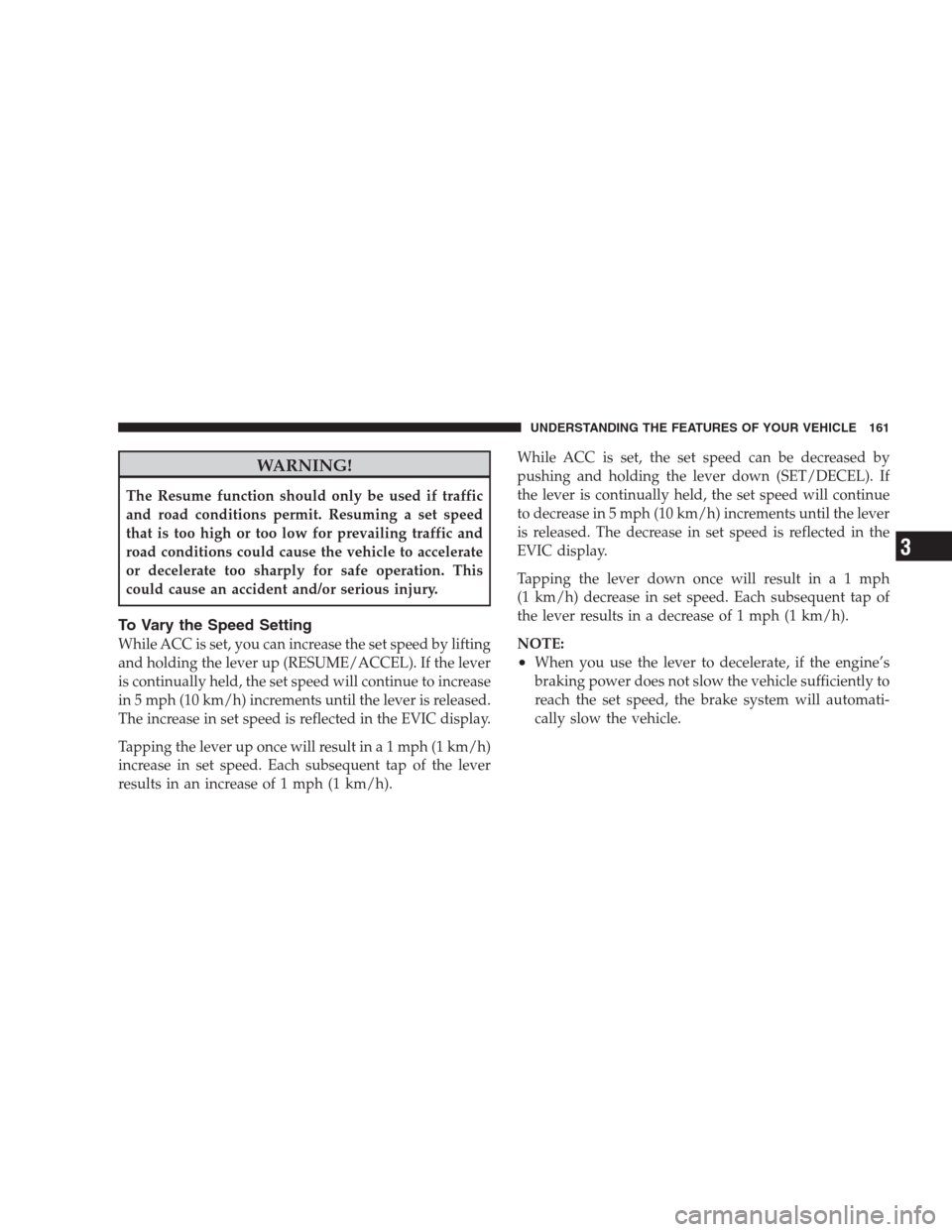
WARNING!
The Resume function should only be used if traffic
and road conditions permit. Resuming a set speed
that is too high or too low for prevailing traffic and
road conditions could cause the vehicle to accelerate
or decelerate too sharply for safe operation. This
could cause an accident and/or serious injury.
To Vary the Speed Setting
While ACC is set, you can increase the set speed by lifting
and holding the lever up (RESUME/ACCEL). If the lever
is continually held, the set speed will continue to increase
in 5 mph (10 km/h) increments until the lever is released.
The increase in set speed is reflected in the EVIC display.
Tapping the lever up once will result in a 1 mph (1 km/h)
increase in set speed. Each subsequent tap of the lever
results in an increase of 1 mph (1 km/h).While ACC is set, the set speed can be decreased by
pushing and holding the lever down (SET/DECEL). If
the lever is continually held, the set speed will continue
to decrease in 5 mph (10 km/h) increments until the lever
is released. The decrease in set speed is reflected in the
EVIC display.
Tapping the lever down once will result ina1mph
(1 km/h) decrease in set speed. Each subsequent tap of
the lever results in a decrease of 1 mph (1 km/h).
NOTE:
•When you use the lever to decelerate, if the engine’s
braking power does not slow the vehicle sufficiently to
reach the set speed, the brake system will automati-
cally slow the vehicle.
UNDERSTANDING THE FEATURES OF YOUR VEHICLE 161
3
Page 164 of 526
•The ACC system maintains set speed when driving up
hill and down hill. However, a slight speed change on
moderate hills is normal. In addition, downshifting
may occur while climbing uphill or descending down-
hill. This is normal operation and necessary to main-
tain set speed.
Setting the Following Distance in ACC
The specified following distance for ACC can be set by
varying the distance setting between long, medium, and
short. Using this distance setting and the vehicle speed,
ACC calculates and sets the distance to the vehicle ahead.
This distance setting displays in the EVIC.
To change the distance setting, push the lever away from
you (DISTANCE) and release. Each time this is done, the
distance setting adjusts between long, medium, and
short.
1 — Sensor Bars. Default Distance Setting is Three Bars = Long. 162 UNDERSTANDING THE FEATURES OF YOUR VEHICLE
Page 165 of 526
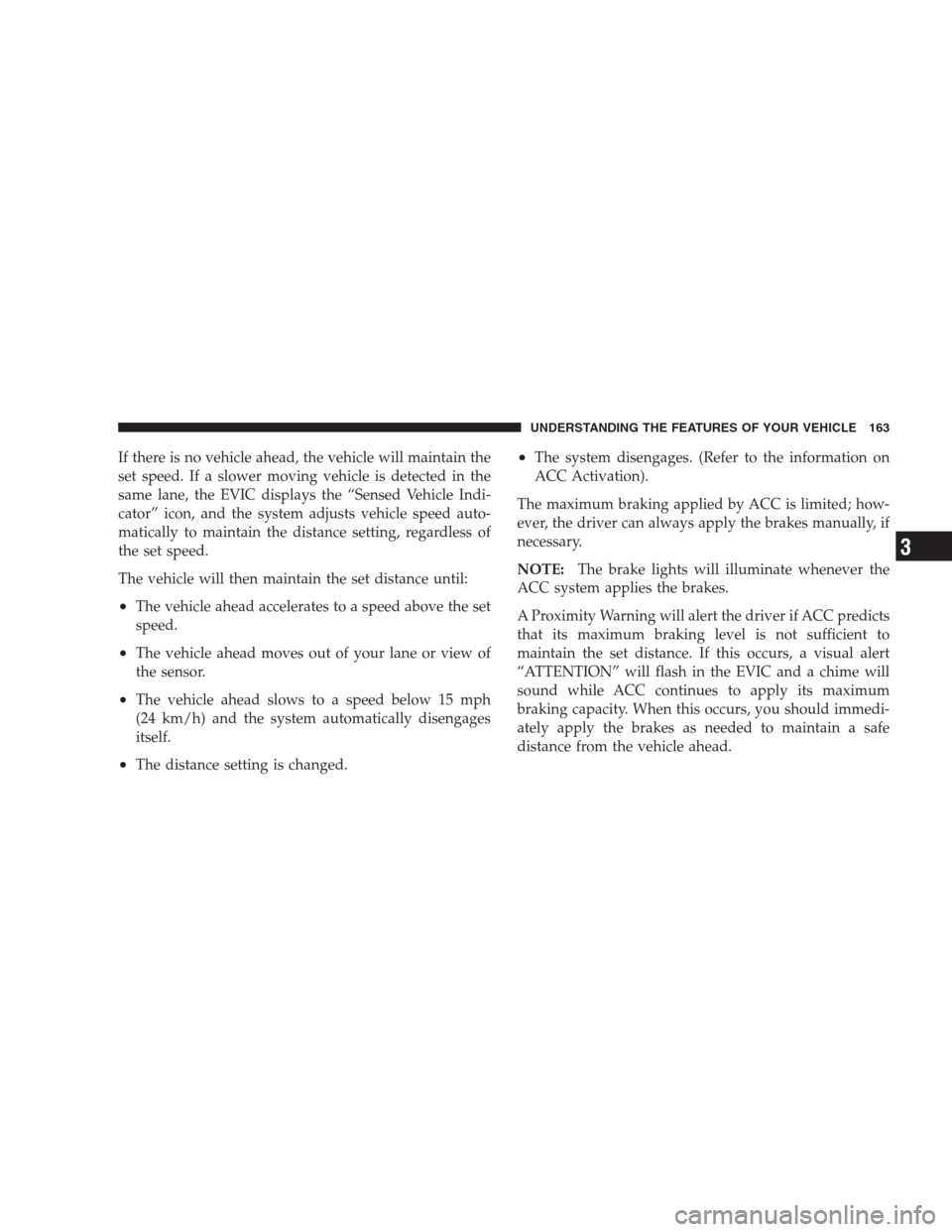
If there is no vehicle ahead, the vehicle will maintain the
set speed. If a slower moving vehicle is detected in the
same lane, the EVIC displays the “Sensed Vehicle Indi-
cator” icon, and the system adjusts vehicle speed auto-
matically to maintain the distance setting, regardless of
the set speed.
The vehicle will then maintain the set distance until:
•The vehicle ahead accelerates to a speed above the set
speed.
•The vehicle ahead moves out of your lane or view of
the sensor.
•The vehicle ahead slows to a speed below 15 mph
(24 km/h) and the system automatically disengages
itself.
•The distance setting is changed.
•The system disengages. (Refer to the information on
ACC Activation).
The maximum braking applied by ACC is limited; how-
ever, the driver can always apply the brakes manually, if
necessary.
NOTE:The brake lights will illuminate whenever the
ACC system applies the brakes.
A Proximity Warning will alert the driver if ACC predicts
that its maximum braking level is not sufficient to
maintain the set distance. If this occurs, a visual alert
“ATTENTION” will flash in the EVIC and a chime will
sound while ACC continues to apply its maximum
braking capacity. When this occurs, you should immedi-
ately apply the brakes as needed to maintain a safe
distance from the vehicle ahead.
UNDERSTANDING THE FEATURES OF YOUR VEHICLE 163
3
Page 166 of 526
Adaptive Cruise Control (ACC) Menu
The EVIC displays the current ACC system settings. The
EVIC is located in the upper part of the instrumentcluster between the speedometer and the tachometer. The
information it displays depends on ACC system status.
Press the MENU button (located on the steer-
ing wheel) repeatedly until one of the follow-
ing displays in the EVIC:
Menu
Button
164 UNDERSTANDING THE FEATURES OF YOUR VEHICLE
Page 167 of 526
CRUISE OFF
�When ACC is deactivated, the display will read
“CRUISE OFF.”ACC READY�When ACC is activated, the display will read “ACC
READY.”
UNDERSTANDING THE FEATURES OF YOUR VEHICLE 165
3
Page 168 of 526
ACC SET
�When ACC is set, the set speed will display.The set speed will continue to display in place of the
odometer reading when changing the EVIC display
while ACC is set.
1 — Sensed Vehicle Indicator
2 — Set Speed
3 — Your Vehicle
4 — Following Distance Setting: Three Bars = Long; Two Bars =
Medium; One Bar = Short.
166 UNDERSTANDING THE FEATURES OF YOUR VEHICLE
Page 169 of 526
The ACC SET screen will display once again if any ACC
activity occurs, which may include any of the following:
•Set speed change
•Distance setting change
•System cancel
•Acquisition/loss of Target
•Driver override
•System off
•Proximity warning
•ACC warning
The EVIC will return to the last display selected
after five seconds of no ACC activity.
UNDERSTANDING THE FEATURES OF YOUR VEHICLE 167
3
Page 170 of 526
Display Warnings and Maintenance
ACC Blinded Warning
The ACC Blinded Warning will display when conditions
temporarily limit system performance. This most often
occurs at times of poor visibility, such as in snow, fog,
heavy rain, or when driving into direct sunlight (sunrise
or sunset). The ACC system may also become tempo-
rarily blinded due to obstructions, such as dirt or ice. In
these cases, the EVIC will display “ACC Blinded” and
the system will deactivate.
NOTE:If the ACC Blinded Warning is active Normal
(Fixed Speed) Cruise Control is still available. For addi-
tional information refer to “Normal (Fixed Speed) Cruise
Control Mode” in this section.
168 UNDERSTANDING THE FEATURES OF YOUR VEHICLE
Trending: remote control, parking brake, set clock, CD changer, automatic transmission fluid, bluetooth, stop start
